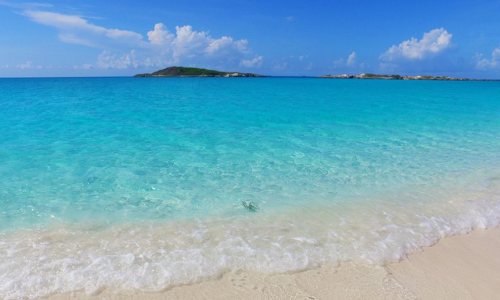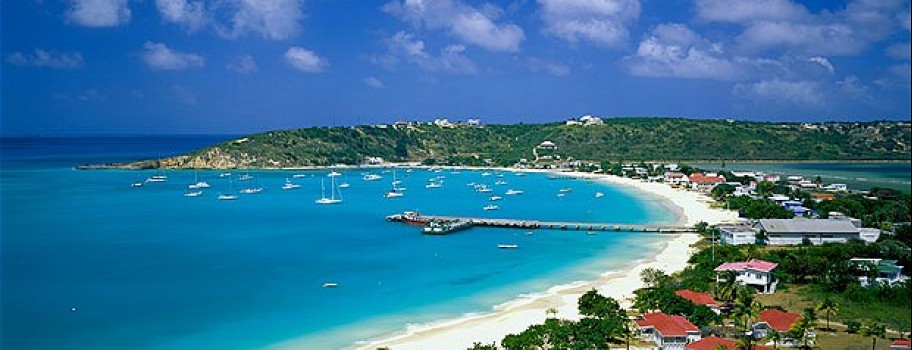
Gay Travel Anguilla
Tucked away in the Eastern Caribbean, Anguilla is the most northern island in the Leeward Island chain, less than ten miles north of St. Martin and 200 miles east of Puerto Rico. Anguilla is off the beaten path, which helps to protect the character and exclusivity while offering all LGBT travelers convenience in getting there by air or by sea.
Envied for its pure, pristine white sands and wrapped in brilliant turquoise waters, Anguilla boasts well over 33 of the most beautiful beaches in the world.
Water temperatures range between 70ºF and 80ºF, perfect for swimming. Most beaches are placid and calm with gentle shoals; occasionally, the Atlantic side of the island can produce some surf. This generally happens in the winter months when swells move off the East Coast of the United States. Surfers can’t be guaranteed waves, but wind and kite surfers find Anguilla to be heaven.
Anguillians are genuinely happy to share the island with all visitors! Down every road, there is something to discover: a bit of their past, a new friend, something in nature, or something new. Guided tours are available but the island lends itself to exploration, as it is easy to get around, and a helpful friend is almost always nearby.
Sandy Ground
Sandy Ground is “the entertainment capital of Anguilla.” A sleepy village by day, at night the imaginative beach bars, and fun and casual restaurants come alive with music, dancing and lively conversation. At night the popular “Pumphouse” jams with dancing, drinking and fun, but by day The Old Salt Factory & Pumphouse is a historic site that showcases the once thriving salt economy. During holidays, Sandy Ground hops all day. Whether you come down to “lime” (hang out) or “mash sand” (dance), it is usually the place to be, and to be yourself.
The Old Valley
On the road to Crocus Hill, is the area of town that Anguillians refer to as The Old Valley. Here there are a number of architectural examples from Anguilla’s yesteryear. Ebenezer’s Methodist Church, Miss Marjorie’s House, The Warden’s Place, Rose Cottage, and other graceful buildings are a reminder of Anguilla’s beautiful past.
Crocus Bay
Crocus Hill, the highest point on Anguilla at 213 feet above sea level, crowns the beautiful turquoise bay and offers spectacular sunset views as well as a bit of history. Crocus Bay is the site of the first military invasion in 1745. Six or seven hundred French soldiers landed on the beach and were fought off by the English settlers in less than fifteen minutes — the first of three invasions that all ended in the invaders’ defeat.
Not too long ago Crocus Bay was a quiet place mostly forgotten by visitors, except to catch Calvin for a ride over to Little Bay. Today, Crocus Bay is home to DaVida’s, an elegant fine-dining experience, and her sister property, DaVida’s Bayside Grill. Calvin is still there underneath the Mahogany trees, and he is still one of the easiest and least expensive ways to get to Little Bay for snorkeling.
Shoal Bay
Home to bright beach bars, blinding white sands, electric turquoise seas, umbrella and beach chair vendors, snorkeling at the coral reef, scuba diving and glass bottom boat tours. While many of Anguilla’s beaches have been mentioned among the world’s best time and time again, none so much as Shoal Bay — “The world’s best beach.”
Heritage Museum
Colville Petty, O.B.E. is Anguilla’s historian and the curator of the island’s Heritage Museum. Mr. Petty has collected and preserved much of the island’s history, from the Arawak Indians to last year’s Calypso King’s photo. His collection is extensive, hands on and unique. Mr. Petty’s museum is located by East End Pond. Be sure to call ahead. His personal accounts, enthusiastic interest and vast knowledge of Anguilla make the experience very worthwhile.
Island Harbour
Anguilla’s quaint fishing town, Island Harbour, is on the East End of Anguilla. Colorful boats moor in this protected cove, and the fishing pier juts out towards the conch-lined island of Scilly Cay. Children jump and fish from the pier, while their parents tend to their boats and the day’s catch.
Amerindian Ceremonial Site
The Sun and the Moon entered the cavern and the stars, earth, and universe were born. The Amerindians believed The Fountain and Big Springs were the site of the creation of the universe. Only recently uncovered and preserved, petroglyphs and artifacts from this primitive time have been found here.
The Wallblake House
The only standing “Plantation House” on Anguilla, The Wallblake House is situated on the Western edge of The Valley next to Anguilla’s Catholic Church. Located across from The Old Cotton Gin, this part of our capital houses some of Anguilla’s more colorful and interesting architecture.
Related Blog Posts
View All Blog Posts in Anguilla
Submit Your Content to be Featured on GayTravel.com
Are you well traveled? Want to contribute content to GayTravel.com, as well as to our widespread readership? From photos to recommendations to travel tips, we would love to see it all! Submit your content to be featured here.


